“We call our work ‘site-specific portraits of clients,’” says architect Carl Pickering, who with fellow architect Claudio Lazzarini owns Rome-based Lazzarini Pickering Architetti. With projects spanning across Europe, Australia, and the Middle East, the phrase “site specific” takes on added significance. “We believe that building on the Amalfi Coast is different from building in Beirut or Paris or New York,” says Pickering. “One should draw from the architectural and artisan traditions that connect to the area.”
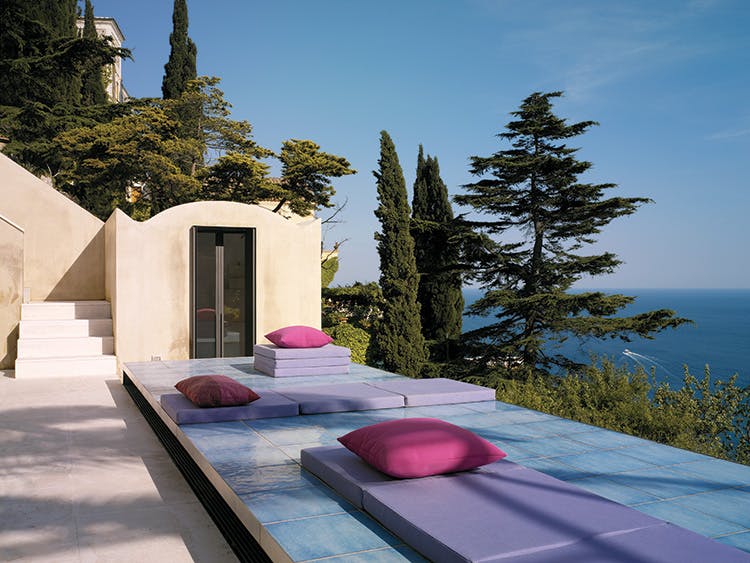
Positano clings to the cliffs along the Amalfi Coast that look out over the Tyrrhenian Sea. That sea served as a channel to connect the city with other cultures, ethnicities, and arts for more than 1,000 years. Vaulted spaces, curved domes, glazed tiles, and richly colored textiles are a reflection of these influences and are all easy to spot in this seaside city. The architecture firm chose inspiration from this melting pot of traditions as they started work on this villa, which began life in the eighteenth century as a convent. “We wanted to interpret the spaces in a very Positano way,” explains Pickering.
The vaulted, double-height living room is flanked by massive arched doorways that open onto a vista of sea and sky. The most striking feature, however, is a sculptural ribbon composed of antique Vietri tiles. The ribbon begins two stories up as a canopy that ultimately runs down the wall. It then transforms into a living room table that morphs into floor tile, leaps across stairs, dipping down again to form a dining room table. It then makes another vertical leap up the wall to end again as a ceiling canopy that houses lights to illuminate the table for diners.
Crafting this ribbon and other tile applications in the home required working with area antique dealers to source all the tiles. The team then configured various patterns on the computer to determine how to lay them out. Despite all the advance work, there was a problem during execution. “When we got there, we could see the layouts we had done were wrong because we combined the colors of the tiles. As we began to lay them out, we realized we needed to instead combine tiles based on the color of white in the background. We had to redo everything,” says Pickering.
Focusing on the white tones gave a sense of cohesion to the design and progression of the ribbon, which itself makes this home stand out from all the firm’s other designs. “The ribbon of tile really is beautiful and specific to this home,” says Pickering. “We haven’t repeated that feature in any of our other projects. It’s the closest we’ve ever come to creating a sculpture.” In another nod to the past, suzani textiles from Uzbekistan hang framed on the walls. The bold colors and repetitive patterns complement the tile work.
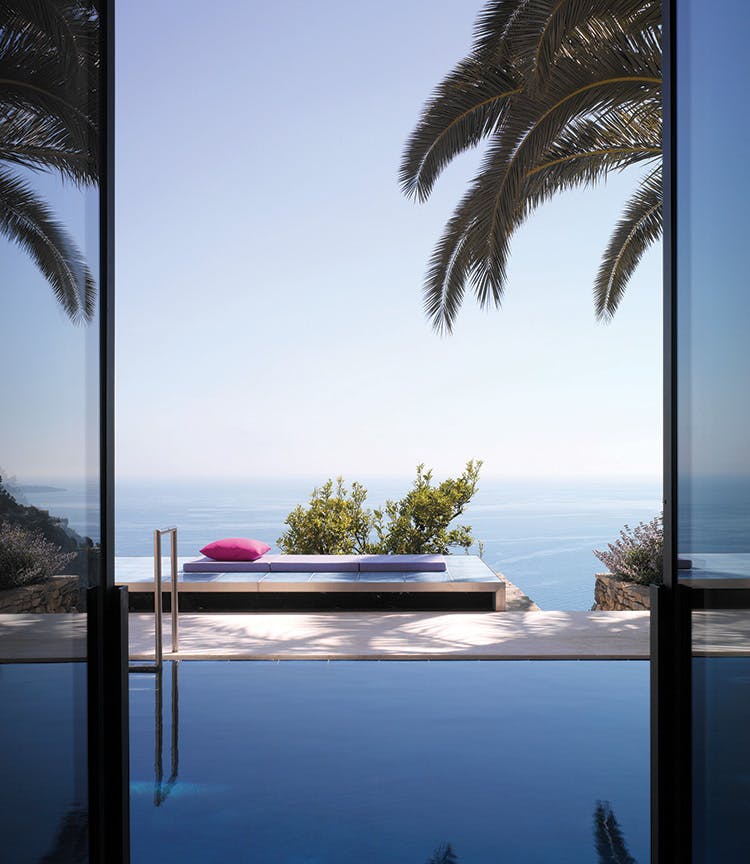
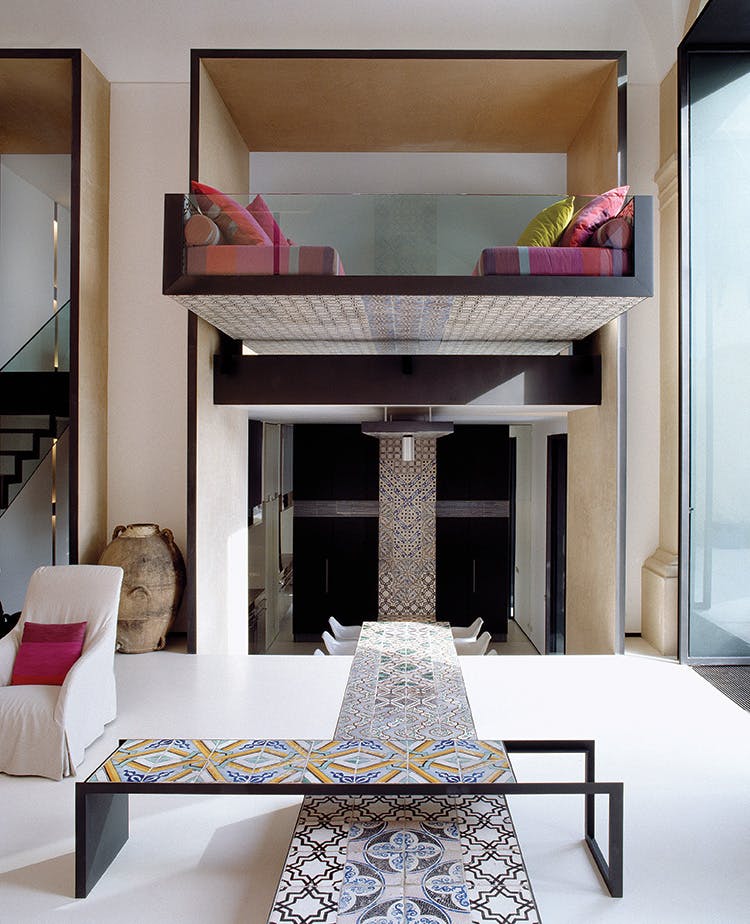
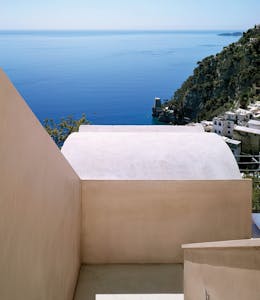
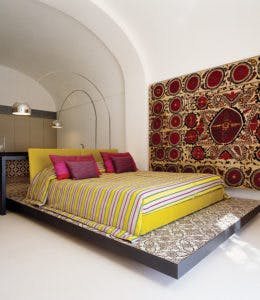
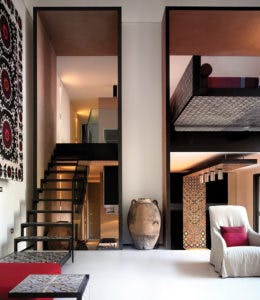
Even though an emphasis was placed on the past, there’s nothing dated or staid about this villa. The architects recognize the history of the area, but also strive to accurately portray the aesthetic of the clients who will live or vacation there. With that goal in mind, this design adds many contemporary touches to the centuries-old home. Even when using antique materials, it’s done in a contemporary way. The tile ribbon itself is framed in steel and glides through the home in an unusual manner. Steel-framed stairs, again covered in tiles, lead the way to another unusual feature—a cantilevered platform that houses what they call the “flying sofa.” That was both a design choice and a practical one. “That was the only point from which one could see Li Galli,” says Pickering of the well-known archipelago off the Amalfi Coast. “It’s a famous view, and there was only one place where we could catch that.” More Vietri tile covers the bottom and sides of that platform.
Additional tiles and another suzani tapestry appear in the master bedroom. The bed sits on a raised platform, again for a practical purpose. The extra height was needed to capture the outside view above the balustrade.
At every opportunity, substantial steel-framed glass doors invite the panoramic views in while beckoning visitors to venture outside. Giant palms and twining wisteria shade the terrace. Puddles of pink pillows and lilac mattresses rest atop a platform covered by wavy blue tiles, meant to hint at the waves below. A lemon grove and vegetable garden provide additional enticement to venture into the summer sun.
“This is a very serene space, very classical and historical,” says Pickering. “But it also has these contemporary touches flying through it—the flying sofa, the stairs, the ribbon. We always incorporate tradition into our designs, while always adding a third millennium interpretation of those traditions.”



